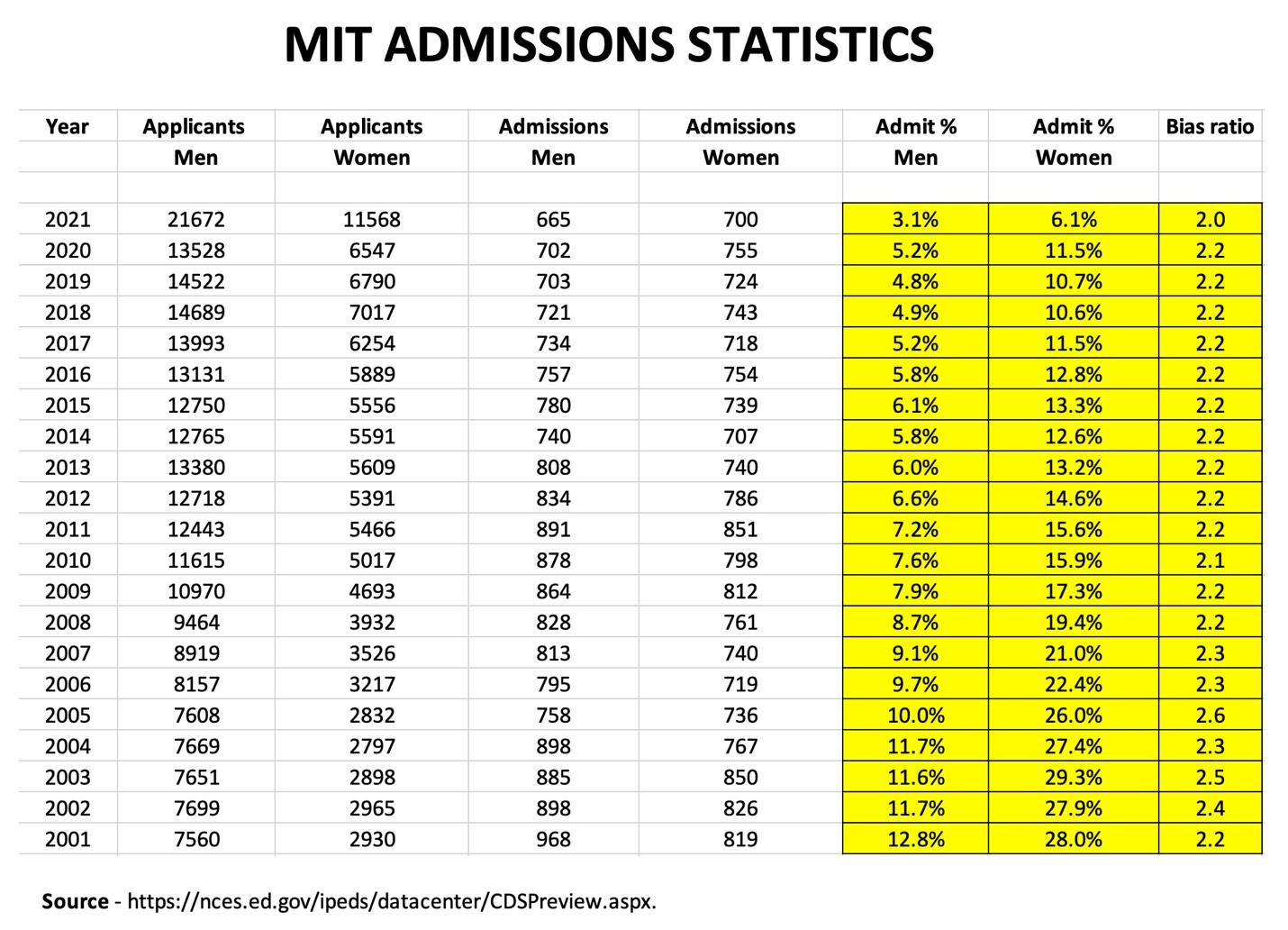By Ayn Honymous
Rivers of ink have been spilled analyzing the recent Supreme Court ruling ending overt race-based affirmative action for college admissions. It begs the question; will this precedent also apply to overt gender discrimination?
The Massachusetts Institute of Technology offers a potentially interesting case. MIT prides itself on having gender-balanced its entering freshman classes for at least the past two decades. How could anyone have a problem with that? And yet, a recent mean-spirited Tweet by Jordan Peterson points to an interesting issue:
https://twitter.com/jordanbpeterson/status/1698990336784159194
What in the world could the old crank be ranting about now? Patiently follow the links down the rabbit hole through the obscure and frankly offensive satire article he was referring to and you find a never-before-published chart of MIT’s undergraduate admissions statistics. Though it took some tedious fact checking, I can verify that the data was correctly extracted from the government’s National Center for Education Statistics database and is not misinformation. (The “bias ratio” column was calculated and is not part of the NCES statistics.)
I’ve been following the use of Disparate Impact Analysis as a legal tool to support claims of systemic bias and illegal discrimination for years and have rarely seen data this lopsided. Not only do female MIT applicants have more than double the acceptance rate compared to males, but the mathematical consistency over the years suggests the clear use of a gender quota system. (A little more investigation of the data on the NCES site reveals why women have a 2.2 admissions advantage rather than simply double. It turns out the female “yield” of accepted students is lower. So, in order to gender balance the resulting matriculated class, the admissions office actually has to accept more females than males.)
Surely, there must be an explanation for this. So off I go digging into MIT’s Admissions Office website, as well as published statements made by its director. One can enthusiastically laud the principles stated. No legacy, donor, or athletic admissions here!
We are egalitarian
For us, egalitarian means that we evaluate all students on equal terms, and on the basis of their own individual interests and aptitudes as opposed to their resources or connections. All admitted students pass through the same demanding process. Before any applicant is accepted, that person’s application passes through at least five distinct stages of review and is evaluated by several different committees composed of admissions officers and faculty reviewers. This process, which is unique in its particular design and has held fast for more than fifty years, guards against an individual’s biases, preferences, or familiarity with a given applicant swaying a decision unfairly and meet the same demanding standard, regardless of legacy status, donor affiliation, or athletic recruitment. We have no quotas by school, state, region, or socioeconomic background, but we also value diversity and believe that it contributes to the merit of each class.
Dig a little further and you find this – https://mitadmissions.org/blogs/entry/diversity-or-merit/
(W)hile not all students admitted to MIT are equally well prepared – and how could they be, with such different experiences? – all students at MIT are sufficiently prepared to succeed at MIT.
We do not admit students who are not prepared to attend MIT. Period. No one benefits. Not MIT, when the student fails out. Not the student, when they could have succeeded somewhere else. Everybody loses. And I hate to lose.
By the same token, we do not admit students who are unqualified for admission to MIT. I define “qualified”, for these purposes, as meaning “prepared” for attending MIT. We are not going to admit anyone, for any reason, who doesn’t possess the qualification, the preparation – yes, the merit – to deserve, and to capitalize on, their admission.
Now, more than half the students who apply to MIT every year are qualified for admittance, by which I mean the majority of applicants are sufficiently prepared to do the work at MIT. The question thus arises: how do we constitute a class from all these qualified students?
This is where the idea of “diversity” comes in. On our What To Do In High School page, we say this of our application process:
When we admit a class of students to MIT, it’s as if we’re choosing a 1,000-person team to climb a very interesting, fairly rugged mountain – together. We obviously want people who have the training, stamina and passion for the climb. At the same time, we want each to add something useful or intriguing to the team, from a wonderful temperament or sense of humor, to compelling personal experiences, to a wide range of individual gifts, talents, interests and achievements. We are emphatically not looking for a batch of identical perfect climbers; we are looking for a richly varied team of capable people who will support, surprise and inspire each other.
Hmm. So, while every individual applicant is evaluated on “equal” terms, the admission decision itself is actually a collective process. That is, the admissions officers – a curiously undiverse group – explicitly state that they are not looking for the very best applicants, however they define it. Rather, they work to assemble a collection of students good enough to survive the rigorous curriculum into a “team” that meets their unspecified subjective criteria.
The extremely high graduation rates that MIT maintains for both men and women attests to the fact that its admissions officers normally get the “good enough” part right. Unlike Ivy League universities where unprepared, underperforming students can slink off into “studies” programs, everyone that earns an undergraduate diploma from MIT has to pass the General Institute Requirements.
The bottom line? Off course a richly varied “team” meeting the collective subjective criteria of an admissions office that is 80% female must be gender balanced! It also means accepting each and every underrepresented minority that clears the “good enough” bar if they are to have any hope of hitting their Diversity Dashboard proportional representation goals. If that means rejecting significant numbers of the very best white male applicants to make room for good enough female and minority applicants, so be it.
Mystery Solved
The question that arises, of course, is … is this all legal in light of the recent SCOTUS decision? MIT is a private university, and white males under 40 are never a protected class. So even if blatant gender discrimination is taking place, it may well pass legal scrutiny. Only a lawsuit will settle that for sure.
Just in case, MIT has prepared a defense against the charge that its admissions process is biased against men. The oft repeated claim is that the female applicant pool is twice as good as the male applicant pool. Hence, the entering classes precisely gender balances itself year after year on merit alone without any fudging. Only the very best women who hold themselves to the highest standards apply, so the narrative goes, whereas tens of thousands of mediocre men with inflated egos apply who can’t clear the “good enough” hurdle.
Call me skeptical, but that’s a tough claim to swallow without substantiating data to back it up. And what would that data be? Easy. Publish a histogram of (de-identified) SAT scores coded by gender with three curves - one for all applicants, one for accepted applicants, and one for rejected applicants. If the first curve shows a disproportionate bulge of poorly scoring males at the bottom of the distribution and the shape of the accepted and rejected curves for males and females roughly match, one can honestly conclude that no gender discrimination is taking place. If not and that data show that a disproportionate percentage of high scoring men are being rejecting while a disproportionate percentage of lower scoring women are being accepted, not only are men being discriminated against but there’s some gaslighting going on attempting to cover it up.
Of course SAT scores don’t tell the whole story. But they certainly gave the Supreme Court plenty of reason to send Harvard’s racist admissions scheme packing. Interestingly enough, MIT cancelled its disastrous experiment waiving standardized tests during the Covid crisis after so many students from the class they admitted without them flunked freshman physics and calculus. The faculty rebelled, forcing the admissions office to reinstate the SAT.
What about it, MIT? Will you fulfill your pledge of transparency and publish these data to put this controversy to rest, or circle the diversity wagons?
# # #
The author is anonymous because she prefers not to be trolled, harassed, demonized, and cancelled. Photo courtesy of DreamStudio.


"Not only do female MIT applicants have more than double the acceptance rate compared to males, but the mathematical consistency over the years suggests the clear use of a gender quota system."
The SAT graphs would seal the conclusion, but that quote really is sufficient. Says it all.
Okay, I'm pretty mixed on this. I'll try to explain.
First off, this is an obvious preferential policy. It's actually worse than that, though, because the original idea behind preferential policies was that if we put our thumb on the scale "for a time", the policy would eventually no longer be necessary because the gap would close, and then stay closed without the need for continued manipulation.
That's clearly not the case here. They've apparently been doing it for fifty years, but the table only covers the past two decades so we can only talk about that. But in those twenty years the gap hasn't really closed at all, so that in the 2021 they've needed to put just as much of a thumb on the scale as they did back in 2000. So, as always, there doesn't seem to be any end point in sight.
So that's bad...
...on the other hand, we must always ask ourselves, "compared to what?" Is this bad compared to the sorts of preferential policies that have been going on in the ivy league for decades? Probably not. Honestly, if all the other top schools had the same General Institute Requirements as MIT, I think it would be a massive blow to "Studies" departments all across the country, and while there might still be discrimination going on, I don't think one could seriously argue that our current situation would be worse than it is right now. So yeah, MIT is discriminating against men, but at least they still have a tool to weed out students who are truly unprepared. AND they reinstated the SAT.
For those reasons I find it hard to pick on MIT. If everyone was "discriminating" in the way MIT was, that would be better than what most top schools are actually doing.
As for the Peterson tweet, he's generally right but it wouldn't apply to this case. MIT is definitely socially engineering a specific outcome, but they're not doing it in a way that will cause the bridges to collapse. (Note that Peterson DIDN'T apply it specifically to MIT, but this author did)